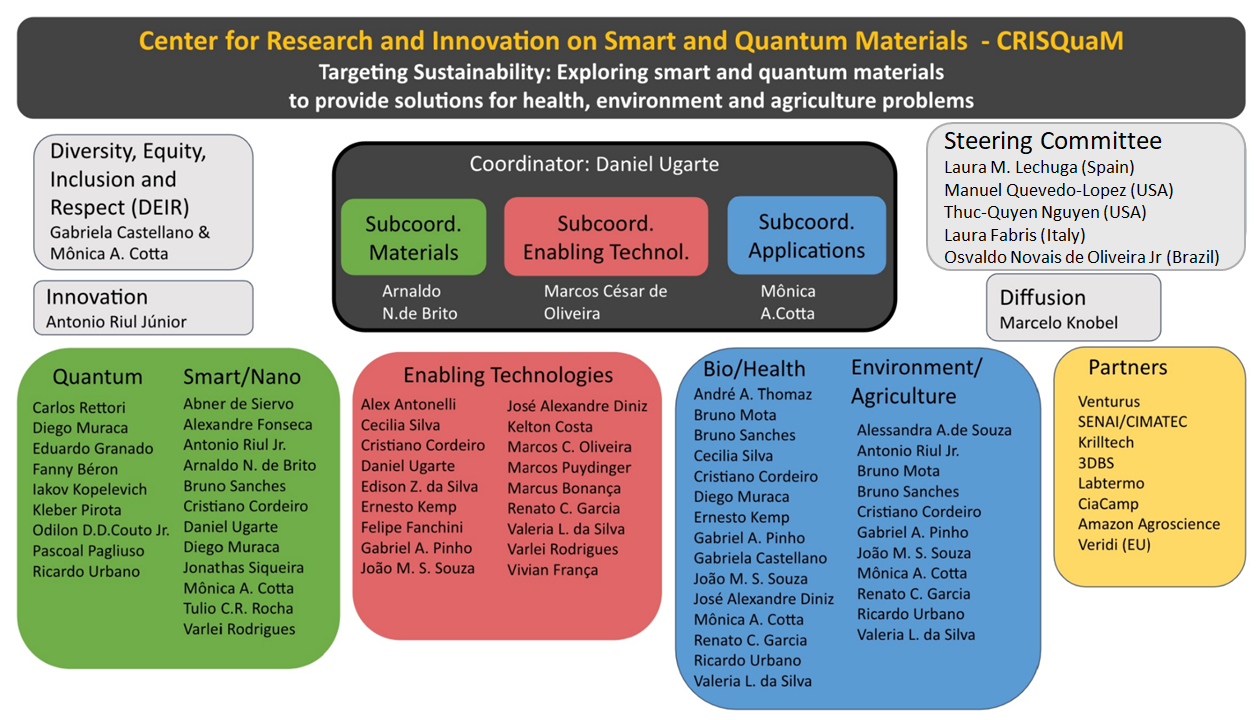BV-FAPESP: research projects supported in this Center
CRISQuaM in the Media: news about the center
CRISQuaM aims to explore the synergistic development of fundamental and applied science to create new materials with high potential for the construction of devices and sensors to address technological challenges related to sustainability, climate change, precision agriculture, ecology, and health. To achieve these goals, we have assembled an interdisciplinary and collaborative research team, integrating expertise across various scientific domains, researching novel materials with high innovation potential. By combining original synthesis methods, advanced characterization techniques, theoretical approaches, computational simulations, quantum technologies, and device construction designs, we aim to drive advances in smart and quantum materials, promoting scientific excellence and technological development. With this, we plan disruptive innovations in instrumentation—including hardware and AI-based tools—as well as in quantum technologies, biomedical devices, and signal processing, in addition to plant bionics, exploring plant-pathogen interactions. Besides research activities, we plan intensive actions in education, dissemination, and communication for the general public, as a modern society should be aware of the challenges humanity faces and how research and technology are essential for responsibly utilizing the planet's limited resources. CRISQuaM's Innovation activities are accelerated through partnerships with several companies in related technologies, many of them Brazilian. Finally, all activities of the Center are managed in accordance with diversity, equity, and inclusion goals and best practices.
The Center brings together scientists, engineers, and innovators in a collaborative effort to apply materials science and quantum technologies at the cutting edge, designing new materials and nano(bio)sensors for advanced diagnostics. The Center has a team capable of producing a wide range of (nano/micro) materials, along with precise chemical and physical characterizations using modern techniques (synchrotron, advanced microscopy, magnetotransport, magnetic resonance, optics, etc.). In addition, the team offers various options in enabling technologies, including miniaturization, processing, and additive manufacturing, as well as instrumentation, quantum sensing, and electronics development. Data analysis will employ updated approaches (numerical simulation, classical and quantum machine learning, and quantum optimization). Applications at the knowledge frontier will address urgent sustainability needs in environmental areas, precision agriculture, plant bionics, and biomedical interfaces, contributing to the development of local technologies in close partnership with the Brazilian industry.
The organization of the Center is based on three pillars — Materials, Enabling Technologies, and Applications — together with partner companies, as described in the figure below.

2025-09-24
To reach this conclusion, Brazilian researchers cross-referenced data obtained from the local public health network with data from an indicator of variations in the Earth’s geomagnetic field. The study was published in the journal Communications Medicine.
2025-09-22
A study published in the journal Nature Astronomy challenges traditional explanations about the origin of the innermost planet in the Solar System and proposes a more likely scenario. The collision would have stripped away up to 60% of its original mantle, which would explain its extreme metallicity.
2025-09-17
According to the expert affiliated with the Brazilian Institute of Geography and Statistics, technology can either reinforce inequalities or expand citizenship, depending on how it is regulated. The speaker at the 6th FAPESP 2025 Conference also pointed out the positive role that artificial intelligence can play.
2025-09-17
Study shows that most of the country’s underground reservoirs will lose their capacity for renewal, increasing the risk of water shortages in several regions, especially the Southeast and South. One strategy to address the problem is “managed recharge,” which includes techniques that promote the infiltration of rainwater or even treated sewage.
2025-09-17
A summary of published studies on the risk of emerging diseases shows that only 7.4% simultaneously consider hazard, exposure, and vulnerability to infection. These three components are essential for reliably and accurately assessing the risk of these diseases in the context of environmental change.